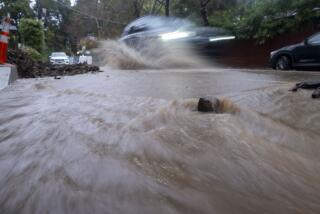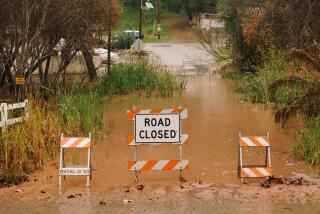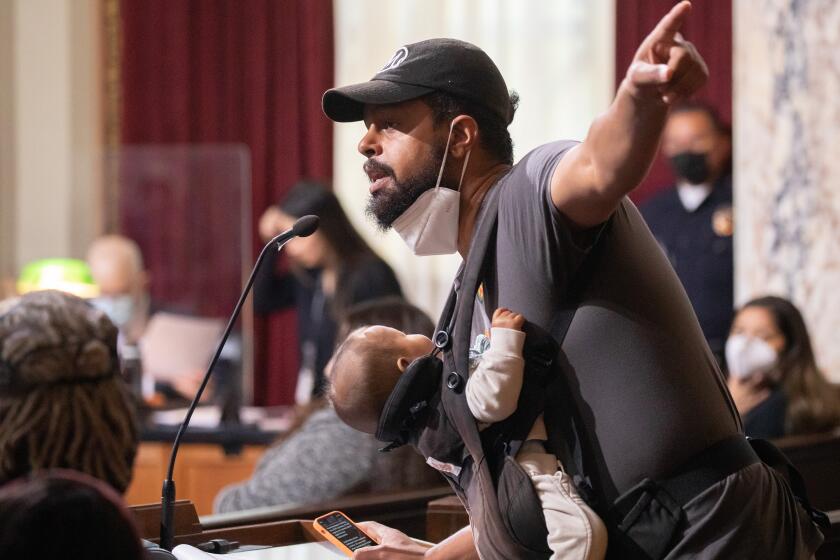Voluntary evacuations sought in Glendora as winter storms approach
Glendora officials increased their emergency flood alert level Wednesday, calling for voluntary evacuations in the Colby fire burn area ahead of two winters storms expected to douse the region.
The storm systems forecast for Wednesday to Saturday are expected to be the wettest weather that Los Angeles has experienced in two years and a welcome reprieve from dry, summer-like conditions during what is supposed to be Southern California’s rainy season.
But in areas such as Glendora and Azusa, where the recent Colby fire scorched more than 1,900 acres of hillsides, the storms are causing some anxiety as residents prepare for potential flooding and mudslides.
PHOTOS: Los Angeles prepares for rain storms
Glendora increased its alert level to orange, which means voluntary evacuation orders were in effect for the Colby fire burn impact area. The alert asks affected residents to remove vehicles, trash bins and other items from streets or travel lanes. Those who do not evacuate will be asked to sign a form assuming liability.
The impact area in Glendora covers all homes and other properties that are north of Sierra Madre and northwest of Little Dalton Wash, officials said.
If Glendora officials increase the alert level again, it will be to red, meaning mandatory evacuations.
Meteorologists from the National Weather Service in Oxnard say the risk of mudslides and debris flows from the burn area is real, and many fire stations have been offering free sandbags.
The first storm, expected to arrive later Wednesday, could drop between 0.25 of an inch and 1 inch of rain across coastal and valley areas in Los Angeles and Ventura Counties.
But the big show -- and the one of most concern to Glendora -- is expected late Thursday night and Friday, when a more powerful system is forecast to drop heavy rain in the late morning and afternoon.
The weather service the second storm could deliver 1 to 3 inches in the coastal and valley areas, and 3 to 6 inches in the foothills and mountains.
The demand for sandbags in Glendora has been so high that the police department sent an advisory Tuesday night, saying the “city yard is currently out of sand but will be refilling starting at 7 a.m. tomorrow.”
“The demand was so high, they just ran through it all,” said Glendora City Manager Chris Jeffers.
Jeffers said the city has distributed about 18,000 sandbags to residents over the last two-and-a-half weeks. If the sandbags were laid end to end, they would stretch 4 to 5 miles, Jeffers said.
Officials hope to get an additional 12,000 sandbags filled between Wednesday and when the big storm hits late Thursday night or Friday.
Jeffers said crews were “working feverishly” to get more than a mile-and-a-half of K-rail cement barriers installed in strategic locations to stop some potential debris flows. Crews were working 16 hours a day, he said.
In nearby Azusa, officials were offering free sandbags at Fire Stations 32 and 97.
“Due to the damage the Colby fire caused to the mountainside in January of this year, there is a potential of landslides occurring with the impending storm headed towards Azusa,” the Azusa Police Department said in a statement.
Glendora knows all too well the danger of heavy rains. Fire in the hills above the city in 1968 led to costly debris flows and mudslides the following year.
“More damage was incurred to property as a result of the 1969 mud flows than the fire itself,” Jeffers said this week.
Officials in Glendora have visited about 60 residents and told them they may need assistance in the event of a crisis. They visited another 150 homes since the Colby fire, advising residents on flood protection measures.
ALSO:
California couple’s gold-coin find called greatest in U.S. history
Google Glass-wearing woman posts video of alleged S.F. bar attack
UC Santa Barbara gang rape: Search and rescue team aids investigation
Twitter: @aribloomekatz | Facebook
More to Read
Start your day right
Sign up for Essential California for news, features and recommendations from the L.A. Times and beyond in your inbox six days a week.
You may occasionally receive promotional content from the Los Angeles Times.






